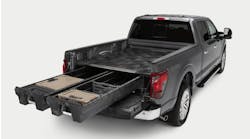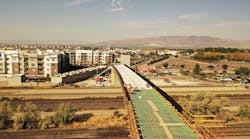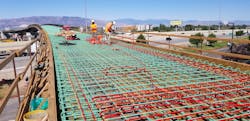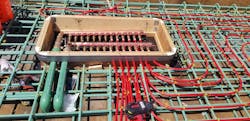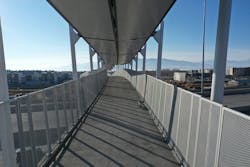Latest from Hydronics & Radiant
Sponsored
Largest Pedestrian Bridge in Utah Gets Radiant Snowmelt System
The new 1,000-foot pedestrian bridge connecting students to the Utah Valley University (UVU) campus was in need of a consistent, reliable snow and ice removal solution that did not require salting or sanding surfaces or moving equipment across the structure. Aron Frailey, owner and chief mechanical engineer of Thermal Engineering, LLC, has decades of experience in hydronic radiant snow-melt systems, but he had never designed or installed a system for a 15-foot-wide (4.6-meter-wide) elevated expanse, suspended up to 35 ft (10.7 m) in the air.
To meet the challenge, Frailey needed piping solutions that would be durable enough for the harsh conditions, but also viable for his construction crew. As a longtime customer, Frailey looked to REHAU for the snow-melt loops of PEX piping embedded in the concrete pathway, selecting RAUPEX® O2 barrier pipe for the job. As the main component in hydronic systems, this PEXa piping provides long-term strength, enhanced temperature capabilities and an extra layer of protection against oxygen permeability with its co-extruded ethylene-vinyl alcohol (EVOH) oxygen diffusion barrier.
“We’ve used REHAU pipe for a long time and never had any issues. It’s like second nature,” he said. “We know it. We know what to expect from it. We have had so much technical support and experience with REHAU.”
Design Elements
He collaborated with REHAU manufacturers’ rep Rocky Mountain Integrated Solutions, Inc. (RMIS) on the project design and material selection. Additionally, engineering consulting company WSP offered design expertise in consultation with the Utah Department of Transportation for the high-efficiency boiler plant and control systems serving the bridge, including NTI Fire Tube Giants (FTG) Boilers with a 2.2 million Btu capacity, Grundfos CR pumps and a Tekmar 680 control.
The design used 34,500 ft (10,516 m) of 5/8 in. REHAU RAUPEX O2 barrier PEX piping for the SIM loops. The PEX piping was fastened directly to the 6 x 6 bridge deck rebar at 6 in (16 cm) on-center spacing before being encased within concrete. The piping was connected to pre-fabricated manifolds that were installed within the bridge deck and accessible via access panels. The manifolds are supplied with a heated antifreeze solution through 1,900 ft (579 m) of 2 1/2 to 4 in (6 1/2 to 11 cm) supply and return piping.
Frailey helped design the manifolds and oversaw their modification and placement during installation. In total, Frailey fabricated seven 2 in (6 cm) custom copper manifold vaults to house distribution piping, using F1960 fittings for connections to SIM loops.
Unique Challenges
The main challenge with the UVU bridge project was the structure’s height, spanning an interstate highway. For hydronic supply and return piping, the original specification called for 4 in (11 cm) steel pipe. Due to its heavy weight, steel piping would require numerous installers, heavy lifts and a lot of welding. Frailey was concerned about jobsite safety of welding that high off the ground under the bridge deck.
Additionally, Frailey was concerned about the function of steel piping in terms of its inability to withstand bridge movement with temperature changes and ease of corrosion. After investigating piping alternatives, Frailey found that PP-RCT provided benefits where steel piping fell short. PP-RCT offered an easier installation with its light weight, eliminated open-flame welding, could flex with the bridge’s movement and could withstand the salt and magnesium chloride Utah uses to melt snow and ice on its highways.
The ability of PP-RCT to move in unison with the bridge was one of the biggest selling points for Frailey. According to him, “The structure is intended to move in every direction all the time—left to right, backwards and forwards, up and down,” he said. “I was concerned about the joint integrity of a steel piping system with all that movement, and I really liked the flexibility of PP-RCT to handle it.”
The radiant loops were also designed with the movement of the bridge in mind. “We designed to match the way they wanted to pour the bridge, so the radiant loops would never cross an expansion joint. Each loop connects to its own custom-built manifold in the slab of that section of the bridge, which then connects to the supply and return piping. REHAU supplied custom 400 ft (183 m) coil lengths to minimize the number of circuits and optimize the radiant design,” explained Frailey.
Making History
A pedestrian bridge has been part of the UVU master plan since 1993 as a way to provide access between the Intermodal Center in Orem and the UVU campus. Funding for the $30.7 million bridge was approved in 2016 and construction began in 2018. The UVU Bridge officially opened in February 2021.
As the SIM system will operate through its first full winter in the 2021-2022 season, Weerts is confident about its future performance. “In-slab hydronic snow-melt systems are one of the most efficient and effective methods for maintaining snow-free surfaces,” Weerts said.
The SIM system is a testament to the teamwork between Thermal Engineering, WSP and REHAU manufacturers’ rep RMIS. Thanks to their collaboration and commitment to quality, students can cross the bridge safely throughout the year without the need for UVU to arrange snow removal services. Frailey concluded, “This bridge is a very effective application for hydronic SIM. I can’t imagine any other practical way of removing the snow, and it operates very cost effectively as well.”
Project at a Glance
Project: Utah Valley University (UVU) Pedestrian Bridge, Orem, UT
Type of construction: Infrastructure for educational facility, opened 2021
Scope of project: 15,000 sq ft (1,394 sq m) of heated walkways at 15 ft (5 m) wide and nearly 1,000 ft (305 m) long
General contractor: Kraemer North America
Civil and mechanical engineer: WSP USA Inc.
Mechanical contractor: Thermal Engineering, LLC
Manufacturer’s rep: Rocky Mountain Integrated Solutions, Inc. (RMIS)
Distributor: Mountainland Supply
REHAU systems used: Snow and ice melting, RAUPEX® O2 barrier pipe
